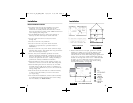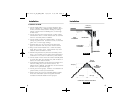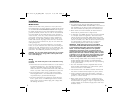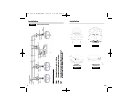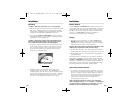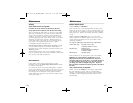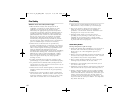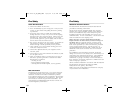
Mobile Homes
Mobile homes built in the past five to seven years have
been designed to be energy efficient. Install smoke alarms
as recommended in Recommended Locations and Image 2A.
In mobile homes that are not well insulated compared to
present standards, extreme heat or cold can be transferred
from the outside to the inside through poorly insulated
walls and roof. This may create a thermal barrier that can
prevent the smoke from reaching an alarm mounted on
the ceiling. In such units, install the smoke alarm on an
inside wall with the top edge of the alarm at a minimum
of 10 cm (4") and a maximum of 30.5 cm (12") below the
ceiling (Image 2A).
If you are not sure about the insulation in your mobile
home, or if you notice that the outer walls and ceiling are
either hot or cold, install the alarm on an inside wall. For
minimum protection, install at least one alarm close to the
bedrooms. For additional protection, see Image 1A.
WARNING: Test your smoke alarm operation after R.V. or mobile
home vehicle has been in storage, before each trip and at least
once a week during use.
Wiring
CAUTION: Turn off the main power to the circuit before wiring
the alarm.
• This smoke alarm should be installed on a CSA listed or
recognized junction box. All connections should be
made by a qualified electrician and must conform to
article 760 of the U.S. National Electrical Code, NFPA 72
and/or any other codes having jurisdiction in your area.
• The appropriate power source is 120 Volt AC Single
Phase supplied from a non-switchable circuit which is
not protected by a ground fault interrupter.
• The alarm should not be operated on power derived
from a square wave or modified square wave inverter.
These power sources produce high peak voltages that
will damage the alarm.
I n s t a l l a t i o n I n s t a l l a t i o n
87
• For alarms that are used as single station, DO NOT
CONNECT THE RED WIRE TO ANYTHING. Leave the re d
w i r e insulating cap in place to make certain that the re d
w i r e cannot contact any metal parts or the electrical box.
• When alarms are interconnected, all interconnected
units must be powered from a single circuit.
• A maximum of 24 Kidde devices may be interconnected
in a multiple station arrangement. The interconnect
system should not exceed the NFPA interconnect limit
of 12 smoke alarms and/or 18 alarms total (smoke, heat,
carbon monoxide, etc.) With 18 alarms interconnected,
it is still possible to interconnect up to a total of 6
remote signaling devices and/or relay modules.
I M P O R T A N T: Kidde alarms and accessories CAN ONLY BE
interconnected with other Kidde alarms and accessories as well
as specified brands and models of interconnect compatible
alarms. Connection of Kidde products to a non-specified
m a n u f a c t u r e r ’s interconnect system, or connection with non-
specified equipment from another manufacturer into an existing
Kidde system could result in nuisance alarming, failure to alarm,
or damage to one or all of the devices in the interconnect system.
Refer to the User’s Guide supplied with each Kidde product for
interconnect compatible models, brands, and devices.
• When mixing models which have battery backup with
models without battery backup, be advised that the
models without battery backup will not respond during
an AC power failure.
• For more information about compatible interconnect
units and their functionality in an interconnect system,
visit our web site at: www.kidde.ca
• The maximum wire run distance between the first and
last unit in an interconnected system is 305 m (1000').
• Image 3 illustrates interconnection wiring. Improper
connection will result in damage to the alarm, failure to
operate, or a shock hazard.
• Make certain alarms are wired to a continuous (non-
switched) power line. NOTE: Use standard CSA listed
household wire (18 gauge or larger as required by local
codes) available at all electrical supply stores and most
hardware stores.
1235-7219-02_AC_MAN_ENG 10/5/04 4:36 PM Page 6





